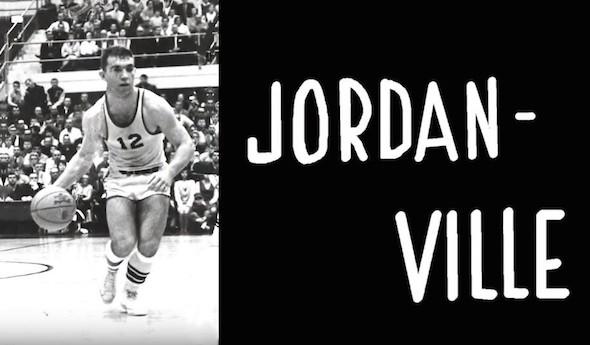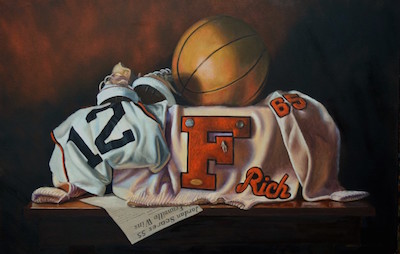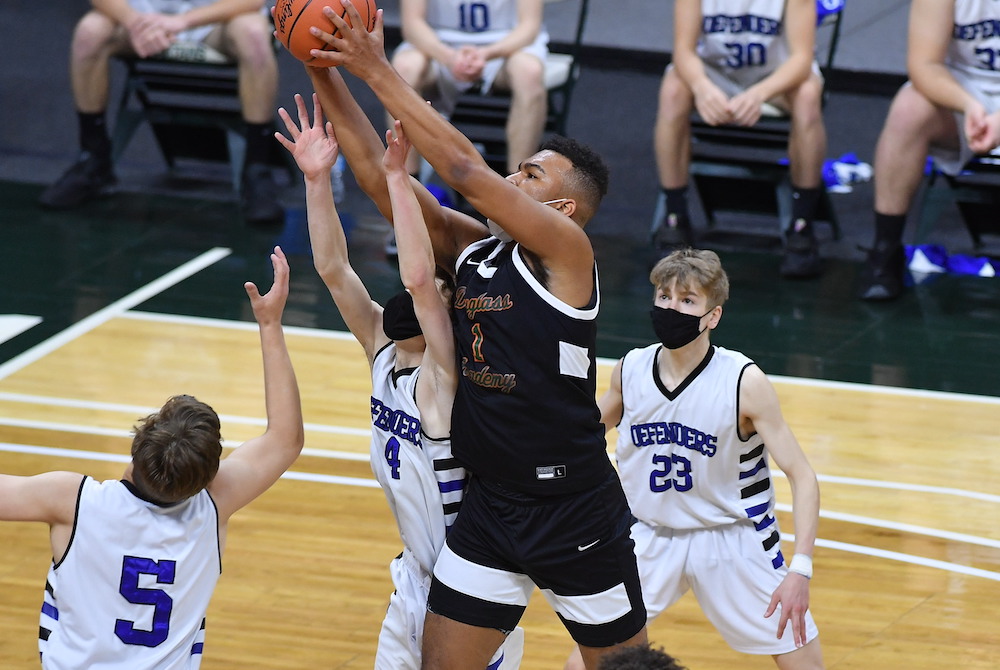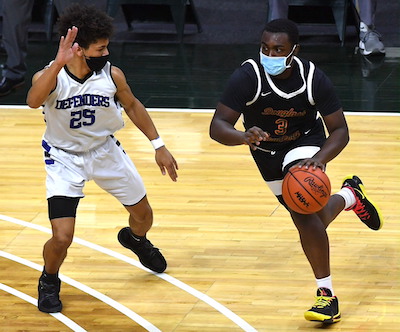
Film Fills In Picture of 'Fennville Flash'
By
Ron Pesch
MHSAA historian
December 28, 2017
We’ve been here before, but not in this way.
The last time was for a retrospective, covering one of the most impressive and awe-inspiring prep careers in Michigan high school history. That time was in print, and included a handful of still images that tried to illustrate the unbelievable.
But this time, the story is in documentary form. It’s woven together from grainy, scratched, faded silent film, a format of capturing memories familiar to thousands of people from generations past, as well as a series of modern-day high-resolution interviews.
Here, the basketball life of the athlete known as the “Fennville Flash” delivers on many levels. Yes, there is a Richie Jordan.
JordanVille, a documentary by John Mooy & Anne Colton, recalls a time when legend spread via word of mouth, newsprint and AM radio.
While it’s hard to comprehend for many today, the exploits of our athletic heroes were formed by “poets in the press box” who sat with pencil and paper, a typewriter, a microphone or a telephone, and described to their audience what they witnessed. On the receiving end, readers and listeners conjured up visualizations based on the facts, phrases and superlatives designed to create an image.
“Traveling left to right on your radio dial” helped listeners feel they were a member of the crowd, seated in the stands, in on the action and a witness to the mayhem. “Packed to the rafters,” reminded fans the importance of what was happening. An exciting game, presented by those with skill, created an event you longed to see. If a broadcast couldn’t be picked up on a transistor or tube radio, the final result might not be known, at the earliest, until the following day’s newspaper arrived.
I’ve told Jordan’s story via the MHSAA before; how he latched on to athletic training, weights and repetition to mold himself into a well-rounded athlete, able to leap to heights unexpected for a kid with a 5-foot-7 frame. The tales of his unfathomable accomplishments slowly leaked beyond the city limits of Fennville into Kalamazoo and greater Southwestern Michigan, then to Detroit. When Detroit Free Press writer Hal Schram relayed Jordan’s feats, the secret traveled across the state and beyond its drawn borders.
From there the legend of Jordan’s accomplishments grew. In Fennville, as in many small towns across the country, the city shut down when a game was played. The Jordan story was so enticing that thousands would travel vast distances to see him play with their own eyes. Today, his single season scoring average of 44.4 points per game during the 1964-65 campaign still remains the top mark in the MHSAA record book.
 JordanVille runs just shy of a half hour. Contained within is insight into the athlete that is challenging to relay in print form. Thanks to access to home movies and a series of interviews with Jordan, former teammates, past opponents and his high school coach, the determination, dedication and drive of a kid who wouldn’t let physical size be a deterrent from achievement radiates from the screen. On display is small town America at its finest, and perspective formed over 50+ years.
JordanVille runs just shy of a half hour. Contained within is insight into the athlete that is challenging to relay in print form. Thanks to access to home movies and a series of interviews with Jordan, former teammates, past opponents and his high school coach, the determination, dedication and drive of a kid who wouldn’t let physical size be a deterrent from achievement radiates from the screen. On display is small town America at its finest, and perspective formed over 50+ years.
For Mooy, it completes a filmmaking journey started six years ago. But the story of Jordan, in his eyes, date back to his school days. Mooy first heard about Jordan as a 7th-grader from a math teacher. A second-team all-St. Joseph Valley League selection, Mooy played at Marcellus High School and scrimmaged against Jordan and the Fennville Blackhawks.
He couldn’t believe his eyes.
“Everyone wanted to see this kid play,” said Mooy in 2011. “He was the first high school player I saw sign an autograph.
Today, with the interviews complete, and the film ready for viewing, Mooy sees more than just a sports story:
“With the benefit of years now passed, I look at the Rich Jordan story with a new respect. JordanVille created a place that was welcoming no matter who you were, or what color your skin happened to be. It was the 1960s. Rich was growing up Jewish, the Civil Rights Movement was in full swing, and the Vietnam War was on everyone's mind. And in Fennville, Michigan, from 1961 to 1965, the Jordan high school years, there were lessons beyond sports being learned by everyone that would last a lifetime. The Jordan household, under the guidance of (his parents) Tuffy and Sylvia Jordan, is where the story begins."
The film speaks of a time that has departed. Competition for our attention was less focused; phones hung on walls or sat on tabletops, communities were tighter, the training table featured peanut butter and chocolate milk instead of protein powder. A city could easily be renamed for a day.
The film also reminds us that those days were far from perfect.
If all goes as planned, the public will see the finished product come the flip of the calendar. In West Michigan, JordanVille is scheduled to show on New Year’s Day at 6 p.m. on WGVU, and will repeat on WGVU-Life at 7:30 p.m., Friday, Jan. 5.
Seek it out, and spread the word, just like in days of old.
 Ron Pesch has taken an active role in researching the history of MHSAA events since 1985 and began writing for MHSAA Finals programs in 1986, adding additional features and "flashbacks" in 1992. He inherited the title of MHSAA historian from the late Dick Kishpaugh following the 1993-94 school year, and resides in Muskegon. Contact him at [email protected] with ideas for historical articles.
Ron Pesch has taken an active role in researching the history of MHSAA events since 1985 and began writing for MHSAA Finals programs in 1986, adding additional features and "flashbacks" in 1992. He inherited the title of MHSAA historian from the late Dick Kishpaugh following the 1993-94 school year, and resides in Muskegon. Contact him at [email protected] with ideas for historical articles.
PHOTOS: (Top) Richie Jordan runs Fennville's offense during his thrilling high school career in the 1960s. (Middle) Jordan memorabilia, as captured by Bill Williams.

Douglass Completes Climb for 1st Championship
By
Dean Holzwarth
Special for MHSAA.com
April 10, 2021
EAST LANSING – Detroit Douglass senior guard Pierre Brooks II sought out his coach, who’s also his father, as the final seconds ticked away.
The pair shared an emotional embrace as they celebrated the program’s first state title with a 47-41 win over Wyoming Tri-unity Christian in Saturday’s Division 4 Final at the Breslin Center.
“This is the best feeling in the world, and especially winning a state championship with your dad,” Brooks II said. “It’s been a long road since my freshman year, and we used to butt heads a lot. Towards the end of my high school career we really started to click a lot more, especially with the pandemic.”
Brooks II, a Michigan State signee, recorded a double-double with 15 points and 11 rebounds to help lift the Hurricanes to the victory in their first Finals appearance.
He also added five assists, two steals and two blocked shots.
“I've never said this to him personally, but Pierre is the best player I've ever coached,” Douglass coach Pierre Brooks Sr. said. “I've been coaching for 22 years, and the work that he puts in on his own and the dedication he has to get better is amazing. I’ve never had a kid like him, and he just so happens to be my son, so this moment is really special for me.”
Douglass’ 6-foot-10 senior center, Javantae Randle, also played a pivotal role and produced a double-double with 15 points and 10 rebounds.
“I didn’t take basketball seriously until I was in 10th grade, so I never thought I would be here,” Randle said. “I never thought we would win a state championship, so I’m going to remember this forever.”
Tri-unity was playing in its ninth Final, but came up short as runner-up for the fifth time.
The Defenders were searching for their first championship since 2011, but were unable to rally in the second half after a strong start.
 Tri-unity played well early, and led 19-13 in the second quarter before the Hurricanes mounted a comeback.
Tri-unity played well early, and led 19-13 in the second quarter before the Hurricanes mounted a comeback.
Brooks II drained a deep 3-pointer during the closing seconds of the first half to cap a 9-0 run and give the Hurricanes a 22-19 lead at the half.
“That was huge,” Brooks Sr. said. “That gave us a little confidence, and I think it swung the momentum in our favor.”
The Hurricanes took control during the final minute of the third quarter.
Randle converted a three-point play, and then seconds later Brooks II stole the ball and threw down a thunderous one-handed dunk to make it 36-27 heading into the fourth quarter.
The lead swelled to double digits with six minutes remaining, but Tri-unity junior guard Brady Titus wouldn’t let his team go away quietly.
Titus, who had a game-high 21 points, kept the Defenders within striking distance, and teammate Owen Rosendall knocked down a 3-pointer with a minute left to make it 43-40.
“We told the guys it was going to be a game of runs, and Tri-unity always makes runs because they are a well-coached team,” Brooks Sr. said. “We had to keep focused, but Titus is a special player and he played a heck of a game.”
Tri-unity coach Mark Keeler had a game plan to try and contain Brooks II, who averaged more than 30 points per game this season.
“We threw the kitchen sink at him,” Keeler said. “We knew that Randle and Brooks were keys to their team, and we tried to make (Brooks) earn every point he got and I think we did a pretty good job of that for the most part.”
The Defenders shot only 33 percent from the field and 20 percent (5-25) from beyond the 3-point line.
“We had a bad start to the second half, and then we had to play catch-up,” Keeler said. “We didn’t take care of the ball at critical times and that cost us, but we were excited to be here and I’m proud of my team.”
PHOTOS: (Top) Detroit Douglass’ Pierre Brooks II (1) reaches high to grab a rebound during Saturday’s Division 4 Final at Breslin Center. (Middle) Douglass’ Damonn Tiggs (3) makes a move toward the lane with Tri-unity’s Brady Titus defending. (Click for more from Hockey Weekly Action Photos.)

